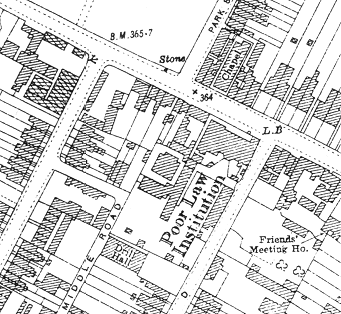Berkhampstead/Berkhamsted, Hertfordshire
Up to 1834
According to the 1725 edition of An Account of Several Workhouses..., parish workhouses already existed at Tring and at Berkhampstead (The now standard spelling of Berkhamsted was adopted in 1937).
A parliamentary report of 1777 recorded parish workhouses in operation at North Church (for up to 34 inmates) and Tring (50 inmates).
In Berkhampstead, a small house attached to the south-west corner of St Peter's church, at the corner of what is now Park View Road, was used to house poor families. Described as a "wretched, straw-thatched building" it was demolished in the 1820s. Just to its west, a workhouse known as Ragged Row operated in a row of tenements on the High Street at the corner of Kitsbury Road. In 1831, a new parish workhouse was built on the Ragged Row site following the bequest of £1,000 by the Revd George Nugent.
After 1834
Berkhampstead Poor Law Union was formed on 12th June 1835. Its operation was overseen by an elected Board of Guardians, 15 in number, representing its 10 constituent parishes as listed below (figures in brackets indicate numbers of Guardians if more than one):
County of Hertford:
Aldbury, Berkhampstead St Peter's (3), Little Gaddesden, Northchurch (2), Puttenham, Tring (3), Wiggington.
County of Buckingham:
Marsworth, Nettleden, Plightlesthorne or Pitstone.
The population falling within the Union at the 1831 census had been 9,871 with parishes ranging in size from Nettleden (population 97) to Tring (3,488). The average annual poor-rate expenditure for the period 1832-35 had been £7,750 or 15s.8d. per head of the population.
The Berkhampstead Union took over the existing Berkhampstead parish workhouse and it by August 1835 it was in operation as the Union's sole workhouse. The building's location and layout are shown on the 1925 OS map, by which time the workhouse had become officially known as a Poor Law Institution.

Berkhampstead workhouse site, 1925
The workhouse had no schoolroom and in 1849, the Poor Law Board recommended that pauper children be sent to the local National School. By 1851 this had become the practice, although in 1858 the school complained about the state of children attending from the workhouse. A fever ward was erected in 1855, and a full-time nurse was engaged in 1868.
The workhouse system officially came to an end in 1930, with control of workhouses passing into the control of local councils. The final meeting of the Berkhampstead Guardians took place in March, 1930. However, the former Berkhampstead workhouse, then known as Nugent House, continued in use until 1935. The building then remained empty until 1937 when the site was sold for £3,700 to make way for a shopping development known as Kitsbury Parade.
Records
Note: many repositories impose a closure period of up to 100 years for records identifying individuals. Before travelling a long distance, always check that the records you want to consult will be available.
- Hertfordshire Archives and Local Studies, County Hall, Pegs Lane, Hertford SG13 8DE. Holdings include Guardians' minute books (1835-8, 1845-1930); Ledger (1897-9); etc.
Staff
Inmates
Bibliography
- Conway, B.J. (1972)The Berkhampstead Union Workhouse 1835-1935 (typewritten manuscript at Hertfordshire Archives and Local Studies).
- Gutchen RM, Truwert E, and Peters G (1984) Down and Out in Hertfordshire — A Symposium on the Old and New Poor Law (Hertfordshire Publications)
- An Account of Several Work-houses for Employing and Maintaining the Poor. Anon, 1725.
Links
- None.
Unless otherwise indicated, this page () is copyright Peter Higginbotham. Contents may not be reproduced without permission.


